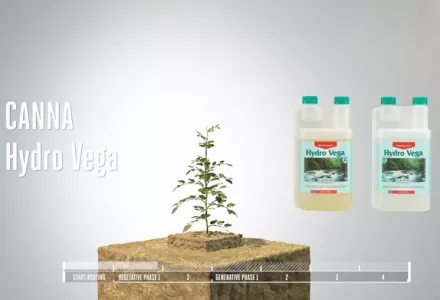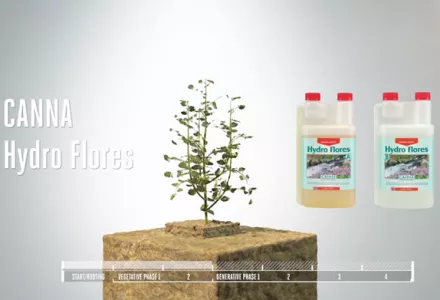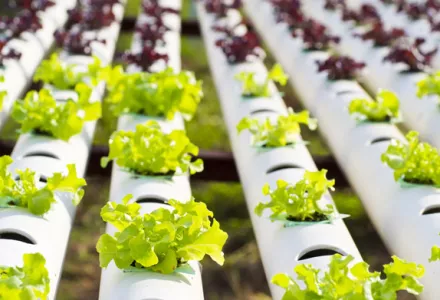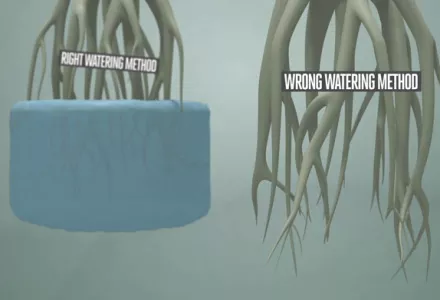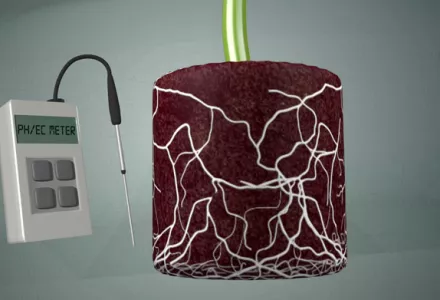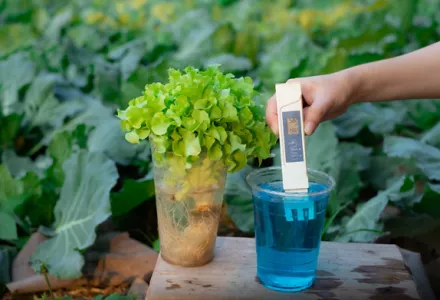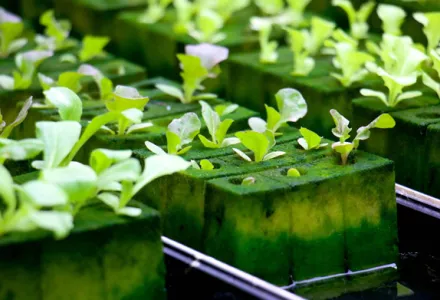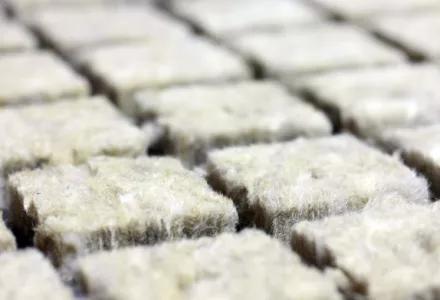Rock wool, a lightweight hydroponic substrate is made from spinning molten basaltic rock into fine fibres which are then formed into a range of cubes, blocks, growing slabs and granular products. Because rock wool and other stone or mineral wools used in horticulture originate from rock, they are considered by many to be a natural product. Rock wool is a widely utilised substrate in commercial horticulture for the production of crops as diverse as tomatoes, melons, cucumbers, peppers, strawberries, herbs and cut flowers; however it can also easily be used by smaller hydroponic growers wanting to take advantage of improved root zone technology.
Where did rock wool originate from?
Rock wool originally started as a thermal insulation material in the construction industry, its lightweight but highly aerated nature helps keep heat inside buildings, while being easy to handle, cut and install. Towards the end of the 1960’s trials were carried out in Denmark to test the possibility of using stone wool as a substrate for hydroponic plants and since then rock wool as a growing media has seen continuing development and improvement.
Rock wool is used by both large scale commercial producers and small growers alike. Rock wool has also developed into a range of products each with different advantages and applications. Apart from the selection of different sized rock wool cubes, blocks and plugs for propagation, growing slabs and granulated rock wool exist for the production of longer term crops and fruiting plants.
Characteristics of rock wool
The way in which the molten rock fibres are stacked and the density inside the rock wool product determine the properties of the growing media such as the moisture holding capacity, the aeration or air filled porosity and the moisture gradient from the top to the base of the cube or growing slab. By altering these properties, rock wool products for different applications have been made available to growers.
One product for example maintains a slightly drier root zone and helps steer crops away from overly vegetative growth, while another is designed for ultra quick root growth and development. This allows growers to choose the rock wool product which best suits their system, crop, irrigation strategy and environment to maximise plant growth and development.
Rock wool and its moisture gradient
Standard rock wool products drain freely after irrigation and will then typically contain 80% nutrient solution, 15% air pore space and 5% rock wool fibres, although these ratios differ slightly between rock wool brands and products. a typical rock wool slab, such as those used for tomatoes and other fruiting crops, contains around 9 litres of nutrient solution immediately after irrigation, despite the drainage holes allowing free drainage of excess solution.
One of the most important characteristics of rock wool is that plants are still able to extract water for growth at very low moisture tensions in the media. That means that plants can easily extract water when the rock wool is saturated from recent irrigation and when the rock wool slab has dried down considerably and lost as much as 70-80% of its moisture content, levels which in other growing media would cause severe wilting in the crop.
The moisture gradient between the top and base of a rock wool growing slab, cube or block is one of the important characteristics of the product. At the base of the rock wool there is plentiful moisture after irrigation, usually at media saturation levels, while the upper layers of the rock wool are held in a drier condition and hence have access to plenty of aeration and oxygen for root uptake and respiration. It is this moisture gradient from top to bottom of the rock wool material which make it such a good hydroponic substrate, but at the same time growers who are not aware of this property can make the mistake of thinking the rock wool is too dry on the surface and over irrigate the plants despite having plenty of nutrient solution help deep down in the root system.
Rock wool, when irrigated correctly should not sit in a pool of nutrient and be completely saturated from top to bottom like a sponge. It is essential that the rock wool is allowed to completely drain so that excess nutrient solution after being applied, leaves the slab or cube under the pull of gravity, in doing so, fresh air is drawn into the top layers of the material providing fresh oxygenation for the root zone. By allowing rock wool to drain freely, over watering becomes more difficult.
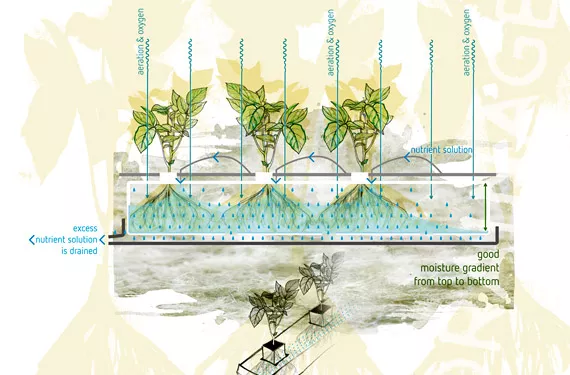
Irrigation characteristics of rock wool
Irrigation of rock wool is a little different to other solid substrates because of the way the material is manufactured to have just the right degree of moisture gradient and because it does give a limited root zone for plants that eventually grow fairly large. For this reason, most rock wool products are best irrigated with short, frequent applications of nutrient solution, with just enough at each irrigation for the rock wool to reach `field capacity’.
Field capacity is a term which means the substrate has drained fully but is still holding a good level of moisture for the plant roots to access until the next irrigation. At each irrigation, there should be some drainage from the rock wool material, however this shouldn’t be excessive. Having around 10-35% of the nutrient solution fed to the plants, drain from the rock wool at each irrigation is considered optimal. This amount of drainage of solution flushes fresh nutrient solution right through the rock wool slab and usually keeps the EC in the slab fairly stable.
EC management
Checking the EC in the root zone is important with rock wool just as it is with any other substrate. While rock wool doesn’t contain any naturally occurring minerals or salts which may influence EC levels, the EC of the nutrient solution inside the growing substrate changes as plants extract different ratios of water and nutrients from the root zone. Careful monitoring and control of both the EC and pH in the nutrient solution in recirculating rock wool systems is just as important as with any other growing media.
Under warmer growing conditions, plants can extract high levels of water from a nutrient solution, thus increasing the EC rapidly and requiring the addition of greater amounts of top-up water in the nutrient reservoir. Under cooler and/or humid conditions, the EC may drop as plants extract nutrients but don’t require as much water, making frequent checks and adjustment of EC levels important for maintaining growth control.
Rock wool has the characteristic of allowing a grower a greater degree of control over the root zone and this can be used to help 'steer' plants into either a more vegetative or generative growth. Drying back of the rock wool slab by increasing the time between irrigations and allowing the EC in the root zone to increase pushes plants such as tomatoes into a more generative state with less leaf growth and more assimilate being directed into the fruit. A higher level of moisture maintained in the rock wool and a lower EC pushes the plants towards more lush vegetative growth. Skilful growers use these techniques in rock wool growing media to direct their crop and control leaf, flower and fruit growth at different times.
Microbial characteristics of rock wool
Rock wool, being a ‘sterile’ product (only directly after production) does not contain any naturally occurring beneficial microbial populations when first planted out, however research has shown that microbial life does develop in rock wool substrates in the same way as other more 'organic’ mediums such as peat and coco. This build up of beneficial microbial populations however is generally slower in rock wool as there are initially limited carbon sources for the microbes to feed on. As root systems develop and produce organic exudate, microbial life inside rock wool gradually build, however rock wool can be inoculated with microbial products to assist this process and help develop a healthy root zone. The high level of oxygenation in a well managed rock wool system also help with the establishment and multiplication of beneficial microbe populations.
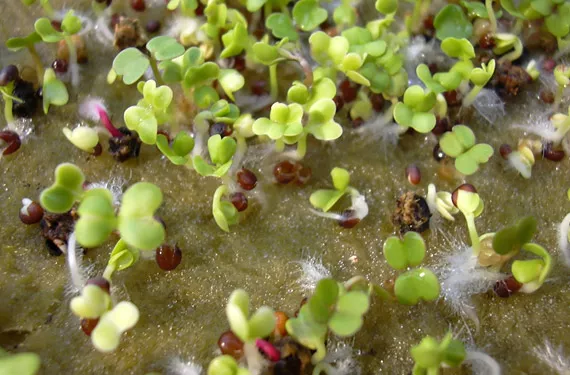
Re-usage characteristics of rock wool
Rock wool, being essentially rock does not decompose, fracture or break down over time, hence growers can use it for many successive crops. However it is recommended that rock wool is steamed or at least treated with boiling water before replanting to help prevent any carry over of root disease pathogens. A thorough leaching with clean water also helps remove any excess salts from the previous crop. Some smaller growers use chemical disinfectants to treat rock wool before use, however care needs to be taken to completely rinse these from the material before replanting and steam or hot water is seen as a much safer option. Eventually used rock wool material has to be disposed off – often growers simply dump this, however it is possible to shred the material and re use it in other growing mixes, or incorporate it into outdoor soils and gardens as a soil conditioner.
The advantages of rock wool
Rock wool has many advantages for hydroponic production: the manufacture of the rock wool fibres from molten rock and plastic wrapping of growing slabs ensures the product is sterile, and free from weed seeds, pests and pathogens.
High quality rock wool brands, being a manufactured product are also consistent in quality and don’t decompose or break down over time in the way that many other natural growing substrates do. Rock wool:
- maintains it physical properties over time and with successive crops.
- is light weight and thus easy to handle and shift into place, once fully irrigated however it becomes heavy and provides stability to the crop.
- comes in a convenient range of sizes from small 2-3 cm propagation plugs joined in sheets for direct sowing crops such as lettuce and other seedlings, to large cubes of over 10cm for more advanced transplants.
- plugs are often used for cuttings where they maintain the ideal levels of aeration and moisture for rapid root development.
- can be inoculated with beneficial microbes such as Trichoderma in much the same way other substrates like coco are, however more frequent applications of microbial products are recommended with rock wool substrates. Most rock wool products and reliable brands don’t have any major influence on the EC, pH or composition of the nutrient solution applied. Since rock wool provides no naturally occurring nutrients a well balanced nutrient product applied will give optimal growth.
- is manufactured to give a close to ideal level of moisture and aeration in the root zone, this helps prevent over watering and root suffocation from a lack of oxygenation.
- can be used for successive crops as its structure does not tend to break down rapidly with use or over time. some commercial tomato growers re use good quality rock wool for as many as 6 successive crops with use of steam sterilisation to control root pathogens between plantings.
- products and growing slabs come ready to use, the substrate only needs to be thoroughly wetted before planting.
- can be monitored with a water content meter which gives accurate measurement of the water content, EC and temperature in the plant’s root zone environment. These assist with fine turning the application of nutrient solution to just the right level for each stage of growth.
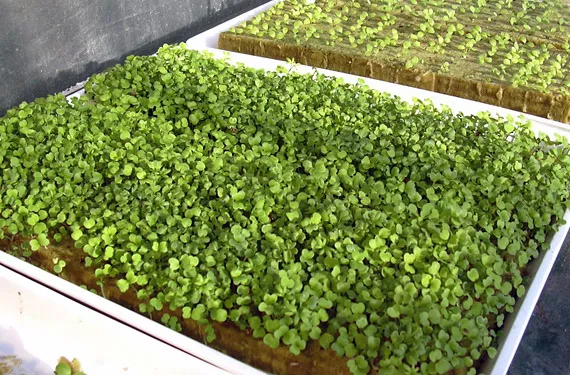
Rock wool disadvantages
Rock wool:
- is bulky to transport and store, unlike coco slabs which can be highly compressed and then expanded with water before use.
- needs to be placed on a fully levelled surface to allow the moisture gradient inside the product to be even and prevent any saturated or overly dry patches from developing. Despite being usable for more than one crop, and some recycling programs developed for used rock wool, disposal can still be a problem for many growers as rock wool does not decompose or break down over time.
- fibres can irritate the skin and a face mask is recommended if handling granulated rock wool or disposing of old rock wool products.
- contains no naturally occurring nutrients (coco often contains levels of potassium and sometimes other minerals which are used to pre condition the substrate), hence the plants are totally reliant on a well balanced and complete hydroponic nutrient solution at each stage of growth.
- being an inert substrate made from rock doesn’t contain naturally occurring growth stimulants such as humic acid, other organic compounds or naturally occurring beneficial microbes, although these can be added with the use of good quality hydroponic supplement products.
New or inexperienced growers need to determine the right frequency and amount of irrigation for rock wool systems as this can differ somewhat from other substrates such as perlite and coco.


